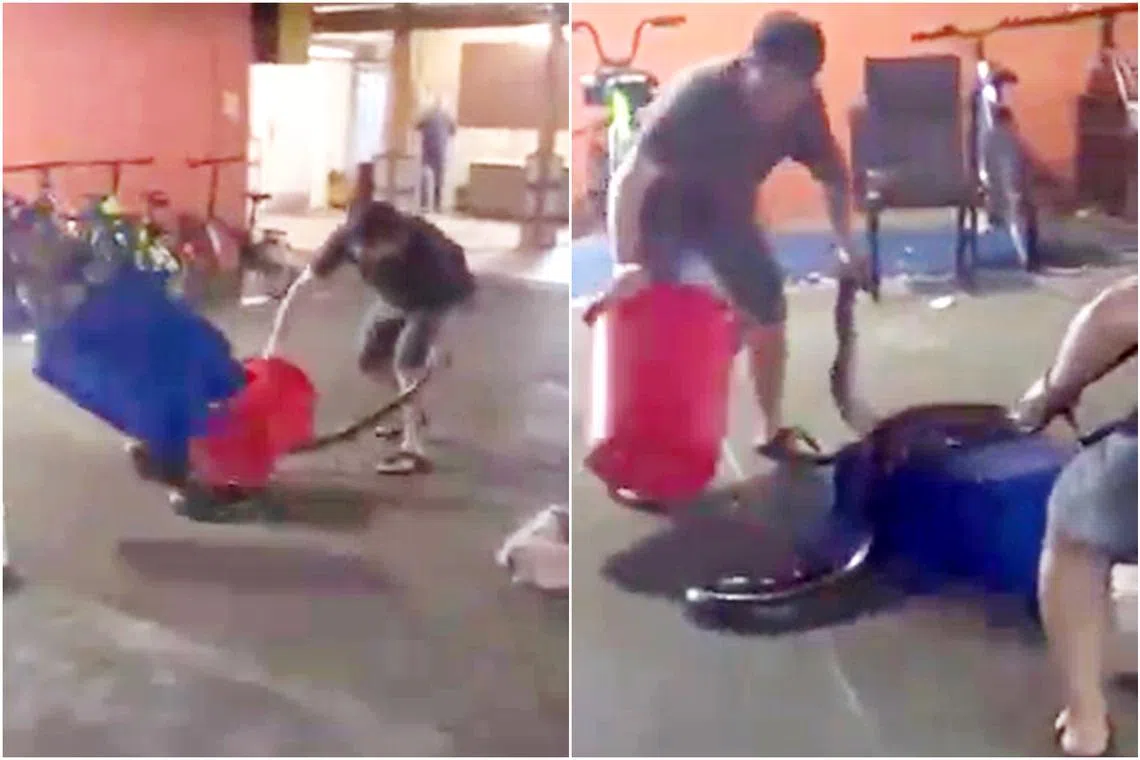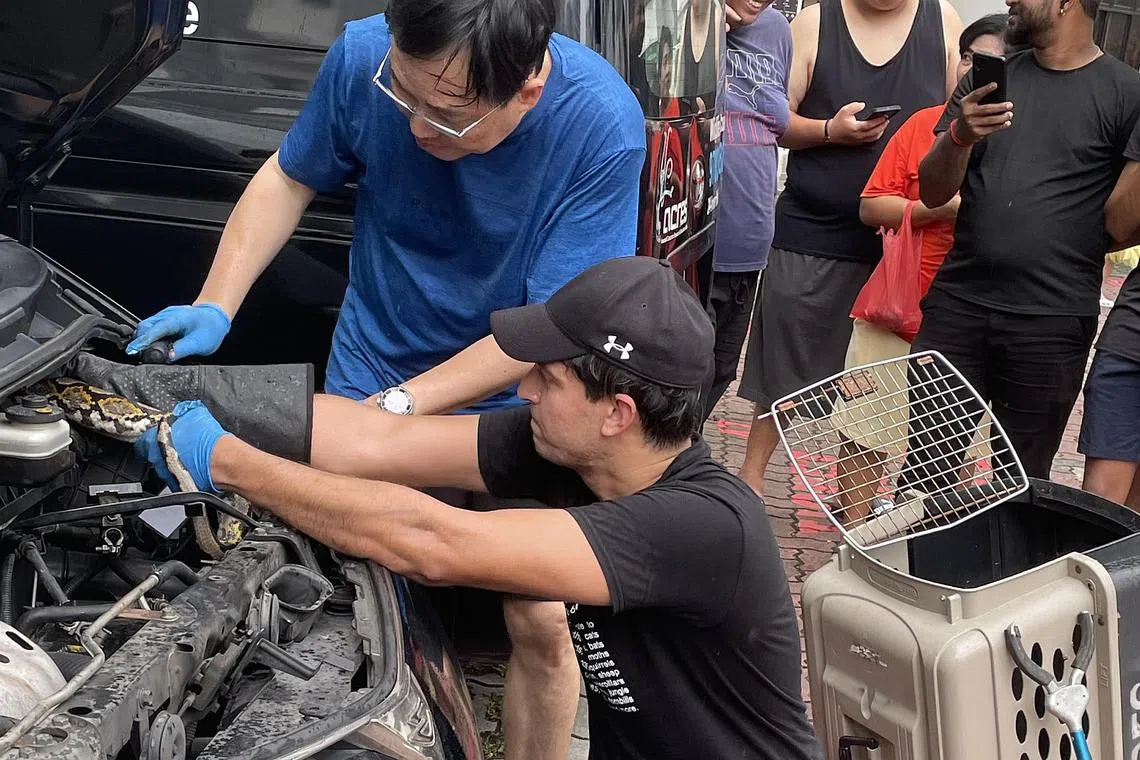Hot water, insecticide or glue traps used to abuse, kill snakes in Singapore: Acres
Sign up now: Get ST's newsletters delivered to your inbox

A 2m-long python was repeatedly hit by plastic pails and crates at Boon Lay Place Market and Food Village and finally hacked to death.
PHOTOS: SCREENGRAB FROM ACRES/FACEBOOK
Follow topic:
SINGAPORE – A 2m-long python was injured in October after members of the public pulled it out from a car’s engine compartment,
Another python, just as long, was repeatedly hit by plastic pails and crates
Cooked food stall assistant Ricky Cheong, 54, was fined $1,000 for killing the snake.
With a reputation for being venomous, snakes are often portrayed in a negative light in literature, movies, the media and even religion. And every year, there are reports in Singapore of the animal being killed and abused.
In the past eight years, wildlife rescue group Animal Concerns Research and Education Society (Acres) has received an annual average of about 14 reports of snakes abused and killed either by hot water or insecticide, or stuck on glue traps.
This is only the tip of the iceberg as the actual scale of abuse here is not known, said Acres co-chief executive Anbarasi Boopal, popularly known as Anbu.
“There is no accurate data available as the snakes, in most cases, have already been killed, and people do not call Acres but just dispose of the body.
“Sadly, it is not uncommon to come across snakes that were sprayed with insecticides, stepped on, crushed with a broom, or had hot water poured on them, resulting in injuries or death,” she said, adding that such actions occur due to fear and ignorance.
From 2015 to 2022, Acres has filed an average of three reports annually to the Animal and Veterinary Service (AVS) – a cluster within the National Parks Board (NParks) – so action could be taken against perpetrators.
NParks director of wildlife management and outreach How Choon Beng said that since 2021, it has received 20 animal welfare-related reports on monitor lizards and snakes, including one where two reticulated pythons were smuggled from Malaysia into Singapore.
It is an offence under the Wildlife Act to kill, trap or take any wildlife without the approval of the director-general of NParks. Offenders can be fined up to $50,000, jailed for up to two years, or both if the offence is committed in relation to protected wildlife.
Ms Anbu said: “We do have strong legislation for wildlife protection. However, when it comes to cases involving cruelty to snakes, the perception that snakes are ‘dangerous’ appears to take precedence over the suffering they go through.
“We need to change this. If you compare the suffering of an abused cat and dog to that of a snake, it is the same. All of them feel pain. So, it is the responsibility of individuals to be aware of our own native wildlife and (what) etiquette to follow.”
Mr Shivaram Rasu, scientific officer at reptile and amphibian enthusiast group Herpetological Society of Singapore (HSS), said: “While there are venomous and/or large snakes of medical significance that are a cause for concern when near human settlements, the vast majority of snakes in Singapore are harmless, even when provoked.”

A 2m-long python was injured after members of the public pulled it out from a car’s engine compartment, scraping its skin.
PHOTO: SHIN MIN DAILY NEWS
Dr Charlene Yeong, a veterinarian from the Mandai Wildlife Group, added that the perception of threat in animals typically arises when they feel cornered or are unable to escape, or when a human gets too close.
“Different species have different thresholds. An adult animal with young may exhibit heightened protective instincts, making it necessary for a greater distance between the human and the animal. Similarly, an injured animal may display increased defensiveness. Understanding these dynamics is essential for fostering coexistence with the wildlife that share our spaces,” she said.
On snakes, Ms Anbu said the Acres wildlife management team handled 889 cases related to “human-wildlife interactions” in 2020. This increased to 1,097 in 2021 and 1,111 in 2022.
“As Singapore evolves into a City in Nature, we can expect an increase in wildlife sightings. We draw wildlife closer to us through greenery, and because we move close to nature as well.
“This is why awareness and tolerance are key to achieving our vision for a City in Nature,” Ms Anbu added.
Dr Yeong, who is also the senior manager of conservation and wildlife health at Mandai Nature, the conservation arm of Mandai Wildlife Group, said that while it is natural to feel apprehensive about potentially dangerous animals, this fear should not translate into a justification for inflicting harm on them.
“Rather, the focus should be on reassuring the animal that you pose no threat by maintaining a safe distance and avoiding provocation. Animals are less likely to exhibit aggression or defensiveness when they don’t perceive danger,” she said.
President of HSS Kamalakannan Raja said: “Education and outreach require a multipronged approach, particularly for herpetofauna (reptiles and amphibians), which generally have less of a good reputation than birds and mammals.
Much of this bad rep comes from misplaced fears, myths and limited exposure.”
With more green spaces, Singaporeans are living in more integrated environments where there are more encounters with wildlife.
Dr Yeong said: “There is likely nowhere else in the world you can see smooth-coated otters swimming in canals, oriental pied hornbills outside a flat window, or even the critically endangered Sunda pangolin ambling by in a nature park.
“This is unique to Singapore, and we must learn to better appreciate the privilege of these wildlife encounters.”


